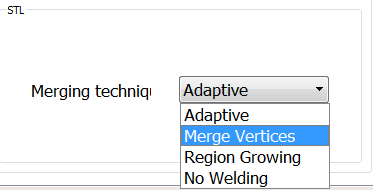File settings related to import and export actions.
OBJ options
There are a few options for the OBJ file format. If you un-check Load Materials and Textures, then Meshmixer will ignore the .MTL file (and hence texture map files) referenced by the OBJ file. There are a pair of options, Import Groups as FaceGroups, and Export FaceGroups and Groups. These options determine how we treat the 'group' lines in OBJ files.
When Import Groups as Facegroups is un-checked, we follow the Autodesk Maya convention and treat each group in the OBJ as a separate object. When this option is checked, we assume the entire file is a single mesh, and each group becomes a facegroup on this mesh.
When Export Facegroups and Groups is checked, we export our facegroups as groups. When these two options are combined, it means you can round-trip an OBJ file between Meshmixer sessions without losing your facegroups. OBJ is the only format for which this is supported.
STL merging
As mentioned in the Import Formats topic, STL is the worst mesh format, ever. Here is why. Inside Meshmixer, you will notice that your triangles are connected. If you pull on one triangle with a 3D sculpting brush, its neighbours come with it. This information about which triangles are connected, well, STL doesn't store it!! An STL file is just a long list of separate triangles.
When we load an STL, we have to figure out which triangles should be connected. This is a slow process, and in some cases it is ambiguous (like if you have any duplicate triangles or near-degenerate edges). This is why sometimes you can export an object that has no holes or non-manifold areas as STL, and when you import it into another program (including back into Meshmixer), holes or other artifacts will appear. So frustrating!
Because this recover-connectivity process has to deal with ambiguity, there are different strategies. You can change the strategy using the Merging Technique drop-down. The Merge Vertices option means that we weld any vertices that are identical (within a tiny tolerance, for ASCII STL), and then try to figure out which triangles are connected based on these merged vertices.

The Region Growing option instead picks "seed" triangles and tries to grow a connected, consistently-oriented region out from the seed. This works as long as the faces are consistently oriented, which unfortunately is not always the case. The Adaptive option runs both of these strategies and then returns the result that has the fewest problems (this is the default). And finally the No Welding option skips this step entirely. You will end up with a bunch of disconnected triangles, which are impossible to edit, but you can use such a mesh in some cases (such as to fit primitives, as a projection target, for measurements, and as an input to Make Solid).
Does this all sound like trouble? It is. No other mesh format has these problems. So please, only export an STL if your 3D printing software is so terrible that it doesn't support anything else. And complain to them!!